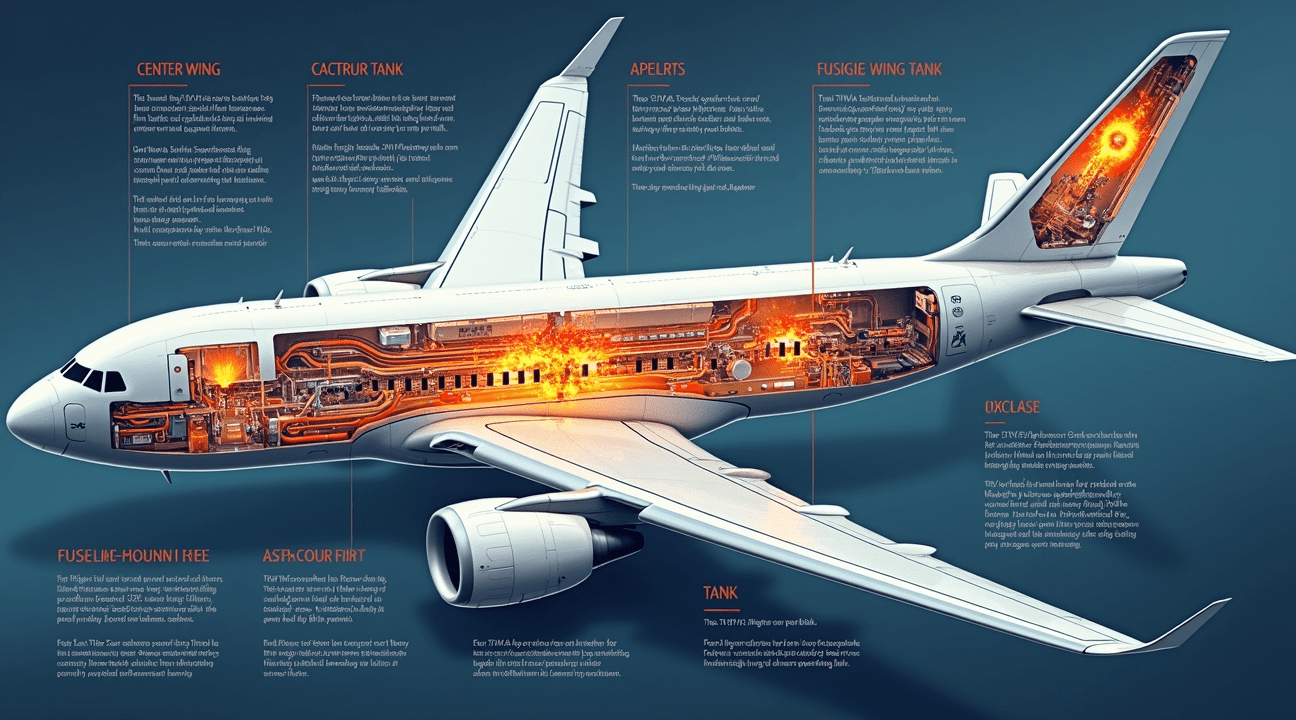Four decades of aviation history have recorded 16 documented fuel tank explosions in transport aircraft, exposing serious safety weaknesses.
Center wing tanks and fuselage-mounted fuel systems demonstrate substantially higher explosion risks compared to conventional wing-mounted designs. The devastating 1996 TWA Flight 800 incident sparked sweeping regulatory reforms, mandating fuel tank inerting systems, strengthened electrical safety standards, and strict temperature control protocols that establish today’s aviation fuel tank safety framework.
Key Takeaways
- Center wing tanks and fuselage-mounted fuel tanks present the highest explosion risks due to their proximity to heat sources and electrical systems, making them more susceptible to dangerous fuel vapor concentrations
- Temperature management is critical for prevention, with regulations requiring fuel tank temperatures stay at least 50°F below the autoignition temperature of the fuel being used
- Fuel Tank Inerting Systems (FTIS) represent the primary modern safety technology, maintaining oxygen levels below 12% in fuel tanks to prevent combustion even when ignition sources are present
- Pilot error causes 95% of fuel management accidents, with approximately 50 preventable general aviation accidents occurring annually due to fuel exhaustion, starvation, or improper tank selection
- Current safety standards require multiple protection layers including improved wiring practices, advanced maintenance procedures, structural integrity assessments, and comprehensive safety evaluations of all potential ignition sources
16 Known Fuel Tank Explosions in 40 Years Reveal Critical Safety Gaps
Aircraft fuel tank explosions represent one of aviation’s most serious safety challenges. Over the past four decades, 16 documented fuel tank explosions have occurred in transport airplane operations worldwide, excluding post-impact events. This data reveals critical patterns that continue to influence modern aviation safety protocols and aircraft design standards.
The distribution of these explosions shows a clear vulnerability pattern across different tank configurations. Center wing tanks and fuselage-mounted fuel tanks demonstrate significantly higher explosion risks compared to traditional wing-mounted tanks. This increased vulnerability stems from their proximity to heat sources, electrical systems, and the aircraft’s structural framework, creating conditions where fuel vapors can reach dangerous concentrations more easily.
The TWA Flight 800 Catalyst
The 1996 explosion of TWA Flight 800 marked a turning point in aviation fuel tank safety. This tragedy, which claimed 230 lives, occurred when the center wing tank exploded thirteen minutes after takeoff from JFK Airport. The investigation revealed that fuel vapors in the nearly empty center wing tank had been heated by adjacent air conditioning equipment, creating an explosive atmosphere that ignited from an unknown electrical source.
Following this incident, regulatory bodies implemented sweeping changes to fuel tank safety requirements. The Federal Aviation Administration mandated new design standards, including fuel tank inerting systems, improved wiring practices, and enhanced maintenance procedures. These regulations now require manufacturers to demonstrate that fuel tank ignition sources are eliminated or that the tank atmosphere remains non-flammable throughout flight operations.
I’ve observed how the industry’s response to TWA Flight 800 fundamentally changed aircraft certification processes. New aircraft must now incorporate nitrogen inerting systems for center wing tanks, while existing fleets underwent extensive modification programs. The investigation also led to improved understanding of fuel vapor dynamics and the critical temperature thresholds that create explosive conditions.
The relationship between fuel type and explosion risk has become increasingly clear through these incidents. Wide-cut fuels, which contain lighter hydrocarbons, significantly increase vapor generation and explosion potential compared to standard aviation fuels. These fuels create more volatile vapor mixtures at lower temperatures, expanding the envelope of conditions under which explosions can occur.
Jet A fuel has demonstrated a substantially better safety record, particularly in wing tank configurations. Its higher flash point and lower vapor pressure reduce the likelihood of explosive vapor concentrations forming during normal operations. However, even Jet A can become dangerous in center wing tanks when subjected to heat from nearby systems or prolonged ground operations in hot climates.
The data from these 16 explosions has driven continuous improvements in fuel system design and operational procedures. Modern aircraft incorporate multiple safeguards, including:
- Improved tank ventilation
- Heat-resistant fuel lines
- Sophisticated monitoring systems that track vapor concentrations and temperature variations
Maintenance protocols now emphasize rigorous inspection of electrical components near fuel systems and proper grounding procedures during fuel handling operations.
Temperature management has emerged as a critical factor in preventing fuel tank explosions. I’ve seen how aircraft operators now implement strict procedures for managing fuel temperatures during ground operations, particularly in hot weather conditions. These include:
- Limiting ground time with fuel in center tanks
- Using air conditioning ground units
- Monitoring tank temperatures throughout flight operations
The concentration of explosions in center and fuselage-mounted tanks has influenced current aircraft design philosophies. Engineers now prioritize separating fuel systems from heat sources and electrical equipment whenever possible. When separation isn’t feasible, they implement additional protective measures such as enhanced insulation, redundant grounding systems, and improved component reliability standards.
Modern fuel tank safety relies on multiple layers of protection rather than single-point solutions. Aviation fuel companies continue developing safer fuel formulations while aircraft manufacturers refine inerting systems and protective technologies. This comprehensive approach has significantly reduced explosion risks compared to the patterns observed in those critical 16 incidents over the past 40 years.

Current Safety Standards Demand Rigorous Temperature and Ignition Controls
I carefully examine how the FAA’s Fuel Tank Flammability Reduction (FTFR) Rule and FAR 25.981 establish comprehensive standards that minimize ignition risks in aircraft fuel systems. These regulations form the backbone of modern aviation fuel tank safety protocols, requiring manufacturers and operators to implement stringent controls that protect against catastrophic failures.
Critical Temperature Management and Safety Assessment Requirements
The FTFR Rule mandates that operators conduct thorough safety assessments of their fuel systems, ensuring no single failure or probable combination of failures can trigger ignition. I observe that this approach demands manufacturers analyze every potential failure mode, from electrical malfunctions to mechanical breakdowns that might create ignition sources.
Temperature control represents perhaps the most critical aspect of fuel tank ignition prevention. The regulations specify that maximum allowable temperatures within any fuel tank must maintain a margin at least 50°F (10°C) below the lowest autoignition temperature of the fuel in use. This safety buffer accounts for operational variables and equipment degradation over time, providing essential protection against thermal ignition scenarios.
14 CFR § 27.963 establishes additional structural and operational requirements that complement temperature controls:
- Fuel tanks must withstand operational stressors including vibration, inertia forces, and structural loads
- Tanks exceeding 10 gallons capacity require internal baffles or supports to prevent fuel surge
- All fuel system components must operate within specified temperature limits
- Proper ventilation systems prevent dangerous fume accumulation
Firewall separation requirements add another layer of protection by mandating that fuel tanks remain physically separated from engine compartments. The regulations specify at least half an inch of airspace between tanks and firewalls, creating a critical barrier that prevents heat transfer and potential ignition sources from reaching fuel vapors.
I find that these comprehensive standards work together to create multiple barriers against ignition. Temperature monitoring systems continuously track thermal conditions, while structural requirements ensure tanks maintain integrity under operational stress. Ventilation systems actively manage vapor concentrations, and firewall separation provides physical isolation from high-temperature engine components.
Companies like Breitling Oil & Fuel must navigate these complex regulatory requirements while developing fuel systems that meet both safety standards and operational efficiency demands. The integration of advanced monitoring technologies with traditional safety barriers creates a multi-layered approach that significantly reduces ignition risks across diverse aircraft platforms.

Modern Tank Design Features Focus on Structural Integrity and Crashworthiness
Aircraft fuel tank design represents a critical engineering challenge that directly impacts both operational safety and structural performance. Engineers must carefully consider fuel tank placement, whether positioned within wing structures, center fuselage sections, or mounted externally, while accounting for fuel type requirements, heat source proximity, and capacity specifications.
Structural Support and Internal Configuration
Large fuel tanks require sophisticated internal baffle systems to prevent dangerous fuel surging during flight maneuvers. These fuel tank baffles serve multiple purposes:
- Maintain fuel distribution
- Prevent excessive weight shifts
- Minimize the risk of fuel starvation during aggressive flight operations
Proper baffle configuration can significantly enhance both performance and safety margins across various aircraft designs.
Structural support systems must withstand not only normal flight loads but also extreme conditions including emergency landings and potential crash scenarios. Modern designs incorporate reinforced mounting points, redundant attachment systems, and energy-absorbing materials that enhance overall crashworthiness. Engineers design these support structures to maintain tank integrity even under severe impact conditions.
Inspection Access and Tank Technologies
Integral fuel tanks, which form part of the aircraft’s primary structure, present unique challenges for maintenance and inspection. Regulations mandate specific provisions for internal access, allowing technicians to perform thorough inspections and necessary repairs without compromising structural integrity. These access points must be strategically positioned to enable comprehensive examination while maintaining the tank’s structural contribution to the overall airframe.
Flexible fuel tank bladders offer distinct advantages in certain applications, particularly where weight savings and installation flexibility are priorities. These bladders must demonstrate exceptional puncture resistance, meeting stringent standards that require a minimum puncture force of 370 pounds as specified in TSO-C80, paragraph 16.0. This requirement ensures that fuel bladders can withstand impact from debris, maintenance tools, or other potential hazards without catastrophic failure.
Personnel compartment installations demand even stricter safety protocols. Tanks positioned near crew or passenger areas must be completely enclosed within fume-proof and fuel-proof barriers. These enclosures:
- Prevent any fuel vapor leakage into occupied spaces
- Provide additional crash protection
The enclosure systems incorporate specialized venting and drainage provisions that safely manage fuel vapors and prevent accumulation of potentially explosive atmospheres.
Emergency scenarios drive many design decisions in modern tank construction. Crash-resistant features include:
- Energy-absorbing materials
- Breakaway connections that prevent catastrophic fuel spillage
- Reinforced mounting systems that maintain tank position during impact events
These features can dramatically reduce fire risk and improve survivability in accident situations.
Venting systems represent another critical safety element, preventing pressure buildup that could lead to tank rupture or structural failure. Modern designs incorporate multiple venting pathways with flame arrestors and pressure relief valves that automatically respond to abnormal conditions. Drainage systems ensure that any accumulated water or contaminants can be safely removed without compromising fuel quality or tank integrity.
Advanced materials continue to evolve in fuel tank construction, with composite materials offering improved strength-to-weight ratios while maintaining the puncture resistance and chemical compatibility required for aviation fuel storage. These materials often provide enhanced corrosion resistance compared to traditional aluminum construction, extending service life and reducing maintenance requirements.
Manufacturing techniques have also advanced significantly, with precision welding, automated assembly processes, and improved quality control measures ensuring consistent tank performance. Modern production methods reduce the likelihood of manufacturing defects that could compromise safety or require premature replacement.
Companies like Breitling Oil Fuel continue developing innovative fuel management solutions that enhance both safety and operational efficiency. These innovations often focus on improving tank durability while reducing weight and maintenance requirements.
The integration of monitoring systems within modern tank designs provides real-time information about fuel quantity, quality, and tank condition. These systems can detect leaks, monitor structural integrity, and alert maintenance personnel to potential issues before they become critical safety concerns.
Poor Fuel Management Causes 50 Preventable General Aviation Accidents Annually
I’ve analyzed accident data that reveals a sobering truth: fuel mismanagement ranks as the sixth leading cause of general aviation accidents across the United States. Between 2011 and 2015, approximately 50 accidents each year could have been completely avoided through proper fuel management practices. These incidents represent entirely preventable tragedies that claim lives and destroy aircraft.
The statistics behind fuel-related accidents paint a clear picture of where things go wrong. Fuel exhaustion, where aircraft simply run out of usable fuel, accounts for 56% of these accidents. Fuel starvation, a condition where fuel exists in tanks but doesn’t reach the engine due to system issues or improper tank selection, comprises 35% of incidents. The remaining cases involve various fuel system complications that pilots must understand to prevent.
Pilot Error Dominates Fuel Management Accidents
Perhaps the most striking finding is that 95% of fuel management accidents stem from pilot error rather than equipment failure. This data point underscores that fuel-related accidents are largely behavioral issues rather than mechanical ones. I find this particularly significant because it means pilots have direct control over preventing these incidents through better decision-making and adherence to procedures.
Experience level doesn’t provide immunity from fuel management errors. Private and sport pilots account for approximately 50% of these incidents, while commercial and airline transport pilots represent 48% of cases. This distribution demonstrates that even highly trained professionals can fall victim to fuel management mistakes when they become complacent or skip critical procedures.
Several key recommendations emerge from accident investigation data that can dramatically reduce fuel-related incidents:
- Visually confirm fuel quantities before every takeoff—never rely solely on fuel gauges or assumptions.
- Understand each aircraft’s specific fuel system. Know how fuel flows, which tank feeds which engine, and how to operate fuel selectors and pumps.
- Maintain fuel reserves beyond legal minimums to account for diversions, delays, or errors.
- Follow checklist procedures rigorously, especially during approach and descent to verify correct tank selection.
The aviation fuel industry continues developing better systems and procedures, but preventing fuel management accidents ultimately depends on pilot behavior. These 50 annual accidents represent families destroyed and aircraft lost due to preventable mistakes rather than unavoidable mechanical failures.
Training programs increasingly emphasize fuel management scenarios, helping pilots recognize decision points where poor choices lead to accidents. Simulator training allows pilots to practice fuel emergency procedures without real-world consequences, building muscle memory for proper responses during actual emergencies.
Regular recurrent training refreshes fuel management knowledge for all pilot certificate levels. Commercial pilots particularly benefit from reviewing fuel planning procedures, as their increased flight frequency can breed familiarity that leads to shortcuts or assumption-based decisions rather than verified procedures.
The aviation community must continue emphasizing that fuel management accidents are entirely preventable through proper planning, disciplined procedures, and conservative decision-making. Every pilot has the tools and knowledge necessary to avoid becoming part of these tragic annual statistics through consistent application of proven fuel management practices.
Advanced Mitigation Technologies and Updated Maintenance Programs
Modern aviation’s approach to fuel tank safety has evolved dramatically through the implementation of sophisticated technological solutions and comprehensive maintenance protocols. Aircraft manufacturers now integrate Fuel Tank Inerting Systems (FTIS) as standard equipment on many commercial aircraft, fundamentally changing how the industry addresses combustion risks.
Fuel Tank Inerting Systems and Their Critical Role
FTIS technology works by continuously reducing oxygen concentration within fuel tanks to levels below the threshold required for combustion. These systems inject nitrogen-enriched air into empty fuel tank spaces, maintaining oxygen levels typically below 12 percent. This creates an atmosphere where fuel vapors cannot ignite, even if an ignition source is present. Airlines have found this technology particularly effective during critical flight phases when fuel levels fluctuate and vapor spaces expand or contract.
The system operates automatically throughout flight operations, monitoring oxygen levels and adjusting nitrogen flow accordingly. Ground crews benefit from reduced safety concerns during maintenance activities, while flight operations continue without additional pilot intervention. Fuel industry developments have supported these safety advances through improved fuel quality standards and handling procedures.
Enhanced Maintenance Programs and Regulatory Compliance
Airworthiness Limitations now mandate specific inspection intervals and maintenance procedures focused on fuel tank ignition prevention. These requirements go beyond traditional maintenance schedules, incorporating dedicated safety assessments that address electrical systems, wiring integrity, and structural components within fuel tank areas. Maintenance teams must document compliance with these limitations as part of their regular certification processes.
Updated maintenance programs systematically address potential ignition sources through multiple strategies:
- Electrical arc prevention through enhanced wiring inspections and improved component specifications
- Hot surface identification and mitigation in areas adjacent to fuel systems
- Lightning protection system verification and testing protocols
- Fuel pump and sensor calibration procedures that prevent electrical malfunctions
- Structural integrity assessments that identify potential spark-generating conditions
Regulatory reviews have prompted design changes across aircraft systems, particularly in electrical components located near fuel tanks. These modifications include improved insulation materials, redesigned wiring routes, and enhanced grounding systems. Lightning protection receives special attention through regular testing of static discharge systems and verification of conductive pathways that safely channel electrical energy away from fuel storage areas.
Maintenance technicians now follow standardized procedures for ignition source mitigation that include:
- Thermal imaging inspections
- Electrical continuity testing
- Component replacement schedules based on safety-critical timeframes rather than traditional wear patterns
These programs ensure continuous compliance with evolving safety standards while maintaining operational efficiency for airline operators.
Sources:
FAA – Service History/Fuel Tank Safety Level Assessment (1998)
Law.Cornell.Edu – 14 CFR § 27.963 – Fuel tanks: general
Flight Safety Foundation – NTSB: Better Fuel Management Could Prevent 50 GA Crashes a Year
Australian Civil Aviation Safety Authority – AWB 28-1 Issue 1, Fuel Tank Safety
Danish Accident Investigation Board – Starved and exhausted: Fuel management aviation accidents
FAA Advisory Circular – AC_25.981-1D
Jetaire Group – Aircraft Fuel Tank Safety Event that Changed Aviation and Jetaire


